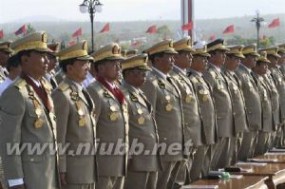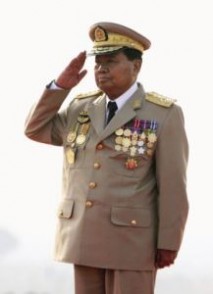一 : 缅甸军政府:缅甸军政府-历史,缅甸军政府-国家进程
1948年3月4日,缅甸获得独立以来,实行的是多党民主议会制。1962年,奈温将军推翻了吴努政府,开始实行由缅甸社会主义纲领党一党执政的一党制,现政府有31个部。
缅甸军政府_缅甸军政府 -历史

1948年3月4日,缅甸获得独立以来,实行的是多党民主议会制。
1962年,奈温将军推翻了吴努政府,开始实行由缅甸社会主义纲领党一党执政的一党制。
1963年初缅甸军政府对地上众多新老缅族政党,如反法西斯自由同盟、联帮党、联合工人党等,进行黄鼠狼给鸡拜年的“诚邀和谈”,半年后就追杀围剿无赦,大规模屠杀各政党领袖。
1988 年9月18日,缅甸军队接管政权以后,缅甸政治迎来了短暂春天。成立了以苏貌大将为首的军政府,取消旧的人民议会和国务委员会,成立了新的国务委员会,宣布解散原来的社会主义纲领党,废除一党制,实行多党议会制。 目前,缅甸主要民主党派大约有十个,最大的是全国民主联盟,国父昂山将军的女儿昂山素季为该党主席。 其次是缅甸民族团结党,由原纲领党重新组建而成。第3大民主党派是掸邦民主联合会。但是好景不长。
1990年5月,缅甸举行多党制民主大选,大选结果,大大出乎缅甸军政府的预料,以昂山素季为首的缅甸民主联盟在大选中获胜。但军政府以必须先制宪才能交权为由,拒绝交权[www.61k.com)。缅甸人民与军政府之间的矛盾进1步加深和激化。
军政府悍然废除联邦宪法,那是1947年组成缅甸联邦大家庭的唯一条约,残忍杀害与拘禁各邦各族领袖,致使签约的掸族、克伦族、克钦族、钦族、孟族等悲痛无比,愤怒抗争。1963年,军政府“邀请”掸邦独立军、掸邦解放阵线、克钦独立军及吉仁自卫队等到仰光协商和平。至该年11月,军政府贼喊捉贼,祭出“捍卫联邦,反对分裂”大旗,至今一直在有组织的烧杀抢劫众土族村庄,大打种族灭绝内战,并用强奸少数民族妇女为战争手段——这些使得各族人民更深恶痛绝大缅族沙文主义、贼喊捉贼的卑鄙行径与野蛮的强迫同化政策,以及要把内战打到底的祸国殃民做法——这就是缅甸半世纪来大民族欺骗、屠杀众小民族,众小民族为求自保而坚持自决权的主要根源。
目前制宪大会已经召开了近7年半之久,但至今仍没有达成一致,仍在断断续续召开,结束遥遥无期,成为世界上最长的会议。军政府答应,待国民大会结束、新宪法制定后,缅甸将按新宪法规定的程序再次举行大选,然后,军政府将把国家政权移交给大选获胜者。近年来,军政府一面用软硬兼施的办法,将各个民主党派逐一瓦解、摧毁,一面组织成立了“缅甸联邦巩固和发展协会”,作为自己的后备力量。
1997年11月15日,将法律与秩序委员会改名为缅甸和平与发展委员会。现政府有3一个部,具体如下:农业与灌溉部、邮电通讯部、建设部、合作社部、文化部、国防部、边境与少数民族发展部、教育部、能源部、财政税务部、林业部、卫生部、内政部、移民与人口部、饭店与旅游部、第一工业部、第二工业部、宣传部、 劳工部、畜牧水产部、矿业部、国家计划与经济发展部、铁道运输部、宗教事务部、社会福利与救济安置部、科学技术部、体育部、经济与商务部、交通部、外交部、仰光市发展委员会(相当于部级)。
缅甸军政府_缅甸军政府 -国家进程

1963 年初缅甸军政府宣布“国有化法案”,所有工商业经济命脉都要由民族资本家与外侨手中,无偿收归“国有”。缅甸军政府用社会主义之名,行排外肥己之实,做起打家劫舍的强盗本行!
1963年2月23日所有外资银行,侨资银行一律由军政府的联邦银行接管。
1964年1月缅甸2大出口商品——大米与木材,分别由军政府的农业局与林业局独家经营。
1964年3月2-19日,全国工商业12212家(95%为外侨所有)被收归“国有”。电台播音刚停,各厂店各企业门口就有兵士奔来,铁门一拉,宣布里内所有东西都已属于“国家”,并规定立即据实上报所有财产物业等,否则坐牢十年。
1964年5月17日宣布流通的100元、50元大钞作废,对民族资本家与外侨再来一次毁灭性打击。全缅流通货币共为2,230百万元,民族资本家与外侨所持的大钞占流通货币的97%,携带不方便的10元、5元小钞只占3% 。华侨等正当财产被无偿没收,正当工作生活被无理禁止,完全违背了联合国人权宣言的最低要求——生存权,华侨求生不得,求救无应,成了绝地孤儿。
自从缅甸军政府掌政40年来,缅甸长年名列全世界最贫穷的国家之一。
缅甸军政府_缅甸军政府 -民族政策
1964年9月1日,军政府“国有化”全国所有报纸。华侨经营的人民报、新仰光报、中国日报、中华商报全被无偿没收,华人华侨从此就没有中文报纸可看了。中文书报也不准进口。
1965年5月,军政府“国有化”所有私立中学,全缅华文中学二十九间,全被无偿没收了,教师全被扫地出门。被无偿霸占的华校在仰光十间:华侨中学、南洋中学、中正中学(三间皆有高、初中),中华中学、福建女子师范学校、华夏中学、业余公学,华英中学、挽华中学。其他城市都是初中华校,如曼德勒、腊戍、密支那、八莫、东枝、景栋、大其力、勃固、东吁、卑谬、兴实塔、勃生、渺名、壁榜、瓦溪码、毛礼、毛淡棉、丹老等共十九间。
1966年5月,政府再“国有化”全缅私立小学:仰光及其郊区共有27间华文小学(仰光市内有:中国、育侨、新侨、华侨、集美、育新、侨尼等小学以及佛学、归女、颍川3个夜校,郊区有阿弄新华、九文台华小、新闻乃华小、甘马育华小、群英、眉尼贡华小、包杜华小、勃生堂华小、达基打华小开方道华小、力行、醒民、新民及南奥、北奥、打汶、丁眼遵等华小)。其他小城市较有规模的也不少于200多间。
至1966年5月,全缅华资华文中小学已经全被无偿霸占为“国有”,两千多华人教师全被扫地出门而无依无靠,约三万华侨子弟被禁止学习本族华文——完全违背联合国制定的人权与少数民族权。对缅甸其他土族,军政府同样用大缅族主义压迫它们,想方设法压制他们的人权与民族权——然而所有土族都有自己的地盘与武装力量,他们在自己世世代代生活的土地上和平抗议不行,就纷纷武装反抗了。
对其他135族群——包括缅甸华族,军政府高举大缅族沙文主义,非赶尽杀绝不可。碰到利益问题,它也决不手软——比如对待昂山素姬领导的民主力量。
二 : 缅甸政府军和缅甸政府
=“传说”那就是我们的人曾经穿着缅甸军服帮着打过克钦。三 : 中国维护缅甸军政府的难言之隐
中南半岛风云骤变,中国为什么要拼命支持缅甸?缅甸在地理上是东盟范围,在政治上并不完全是。因为其是军政府统治,尽管泰国有时也会是军人当政,但总是要回归民主的。不会如缅甸一样军人上去就不下来,这是同世界潮流相背的。东盟内部对其也是持一种排挤态度。这种统治方式是不得人心的,而且有素济这样一个持西方民主立场的人,主流西方世界当然要支持他。 缅甸的问题一直就存在,军人当权也不是一年两年了。只不过这几年美国人忙着反恐,暂时顾不上这群烂军人。 美国人想军事解决缅甸也不可能,风险太大。 美国人最希望的是通过制造国际压力和宣传,希望在未来不远的将来由素季领导人民推翻军人统治,同时希望近邻老窝也因此变性而已。 现在又提出缅甸问题,一是其国际道义不允许其老不过问此事,再忙也要给民主的朋友们一个支持。或者说其认为缅甸现政权已处于摇摇欲坠之中,需要再加上把力,但我觉得缅甸军政府好象并不是短期内就能倒的。 二是因此陷中俄于不义之中,让朋友们瞧瞧这两个国家就是在支持军人独裁统治。 三是预先消了中俄在安理会之不合作的的火气和底气。其逻辑是这样的:俄国,尤其是中国,是不经常在安理会行使否决权的,迫不得已才否决。在无关美国大局上捅出缅甸问题,先不妨让你们行使否决。在下次关键的伊核问题上,中俄双方在下次做选择时会面对更大的自我压力。也就是将缅甸问题做为先交换的棋子,或第一轮先冲上去的炮灰。也恰说明美国提出缅甸问题并不是想为了解决缅甸问题。醉翁之意不在缅甸,在于世界何处山水?或者说,拿缅甸起舞意在——? 四,同时也可能存在如下可能,就是美国以这种方式来警告缅甸现政权,不要同中国走得太近,比如有人老说的中缅通道的问题。尽管中国对缅甸的重申了支持,但从现实角度讲,缅甸现政权并不会去支持中方建立所谓的中缅输油管线,中国事实上也不会去要求缅甸这样做。因为这并不是中缅之间的最重要的问题,中缅之间最重要的就是双方交界处的问题,这个问题在未来对中国更为重要。同时缅甸现政权最希望的也是美国人最好将他们忘了,而不是老来找碴。缅甸必竞没有小金的能耐,还没学会反过来要价的本事。因此美国通过宣称收拾缅甸也会取得其在同中国较量中想要得到的效果。 为什么说这是最后一种可能?因为在我来说,中缅战略通路的可能性不存在。主张同一个美国制裁的国家来共修什么输油管线来解决未来可能美国掐中国脖子的问题,本来就是不是脑子有些进水的想法?你刚修完,美国人就可以以我们正在制裁缅甸为由将这条管线做废,都不需要发起新的制裁。你的海军难道会为缅甸保驾护航?更不要不说这个被美国制裁的政权能活多久的问题。 下面说说中缅之间最重要的问题,现在来说可能并没有显示其重要性,但这个问题在未来如果被外界利用也会非常麻烦,就是中缅边界之间的问题。 缅甸问题对中国来说,存在着一个隐性的却是严重的可能的领土纠纷问题。在缅甸近于中国边界处,存在着众多的事实上脱离缅甸中央政府的半独立的特区,这些地区事实上在中国和缅甸中央政府之间周旋。其居民可以说是中国人,也可以说是缅甸人。 缅甸军政府因为需要中国的支持并且无力解决边疆的这种状态,现时期只能任这种状态持续下去。一定程度上讲,也可以认为是缅甸军政权为了维护其腐朽统治而放弃了一部分正常的国家利益。 而中国政府在奈温政权时期由周与其划定了边界,并且很大程度上是为了共同打击当时处于中缅之间残余的国民党势力。因此,当国民党势力完全终结后,这个边界在国际法上不可更改。 为了稳定中国同东南亚的关系,中国也不可能采用更进取的方式,就是在中缅交界贩毒最猖狂危害最大之时而缅甸中央无力控制之时,中方也并没有越界扫毒。只是希望更多地加强对于这些半独立区的控制来解决问题。但这一定程度上讲应当是缅甸的民族主义者们不希望的。 因此,如果缅甸军政府倒台,上台的是素季或其它的民主式的政权。这个问题在美国的支持下,无论是以扫毒的名义还是以加强中央集权的名义,会自然被放大。就会出现中国干涉东南亚或向东南亚扩张的说法。中国用了近三十年时间试图一步步消除东南亚近临小国对中国内心深处的不信任,到现在,初见成效。如果缅甸政权在美国控制之下,这个不存在的问题是一定会被美国或INDIA想方设法吵作出来的。中方将被放在进退维谷的地步,同时又一次成了犯罪嫌疑人。中国对东南亚做的工作和让步可能全都白干了。 事实上,因为主权问题的限制,中方希望在中缅问题上最好的结果仍然是维持目前这种状态,就是事实上形成一个半独立的缓冲区。无论是美国因素还是INDIA因素,中方都不希望其在中国的西南边境出现。无论是以加强缅甸中央集权的名义还是以加大扫毒,由美方在未来的缅甸军队中派驻顾问的方式。中国也并不一定想拉缅甸来对抗任何国家,因为中缅之间本身就存在潜在的大问题,只要这个问题不爆发,就是中国对缅甸的成功,更何谈进一步拉缅甸来对抗别人?这同中缅之间不可能存在战略通道是一个道理。 缅甸国内如何,谁来统治如何统治对中国来说并不重要,是军人还是素季,只要能维持现状。关键的是,中国必需不能让缅甸成为中国的下一个近临的火场。同时必竞现军人政权因为需要我们的支持而同意目前中缅之间这种结果。而素季或未来的其它来者?我们无法判断。投之以桃,送之以李。我们最起码没有给她投之以桃。 因此,如果缅甸成为中国的下一个越南也是中国非常讨厌的事。所以,中国必需要支持缅甸现军人独裁政权。并不是因为他们独裁才支持他们,而是因为现缅甸政权对中国最为有利。不妨说,在这个问题上,任何形式的中国政府都会支持这个军人政权,无论现在是什么人或什么党在执政。 同时,中国也要考虑下一步,就是任何军政府都是有悖于世界潮流的,倒台是必然的,就是何时倒的问题。中国不能因为支持现政权就因此培养出下一轮的缅甸的反华政权。不过,有中国在中缅边境的实际影响力和一定控制力,到任何时候,中国总是有本钱。四 : 军人政权统治后的缅甸

IN the late1950s, two Americans with a keen interest in political dynamics inSoutheast Asia published a best-selling novel set in a fictitiouscountry called “Sarkhan” – “a small country out toward Burma andThailand”, as the monolingual political hack owed a favour by hisparty whom Washington sends out as its ambassador is told when heis offered the post. William Lederer and Eugene Burdick usedSarkhan as a generic mainland Southeast Asian country of the highCold War, a land with graceful people and an ancient culture, apredominantly rural society with a sophisticated elite over whosefate the West and the Soviet Bloc were locked in a brutal contest.Was the Sarkhan of The Ugly American really Laos, Thailand, Burma,Cambodia? It had traces of all four. It was meant, as noted, to begeneric.
Few observers have consideredMyanmar generic for a long time. By the time of the fall of Saigon,its xenophobic “Burmese path to socialism” had already led many toview it as a quaint Southeast Asian outlier. After the 1988-1990period – which brought terrible blood-shed on the streets ofYangon, the rise of Daw Aung San Suu Kyi, the abrogation of herparty’s election victory, the introduction of naked military rule,international pariah status and deep economic decline, and a long,long wait for a break that many thought would not come in theirlifetimes – Myanmar’s particularities appeared even more striking.Neither have the events of the past 18 months made it seem any lessgeneric, above all in the eyes of those who would now hail it as“the last economic frontier in Asia” and join what the editor of aleading Yangon weekly recently – and ironically – called thecurrent “Myanmar rush”.
Such views were always deeplysilly. Thankfully, the marked change in Yangon’s climate relativeto six and even three months ago has now made them demonstrablysilly. This change is encouraging. Facts on the ground are becomingclearer. The realities that will define Myanmar’s political economyin the medium-term future seem to be coming into focus. For foreignfirms and governments and international organisations that takeSoutheast Asia seriously, whose understanding of the regiontranscends the level that one associates with, say, the leadershipof American chambers of commerce in Southeast Asian capitals or thepampered, parochial globalists-in-their-own-minds who staff theInternational Monetary Fund (IMF) and the International Bank forReconstruction and Development (IBRD), this is goodnews.
As the irrational exuberance ofthe past year ebbs, Myanmar is not becoming Sarkhan. The high ColdWar in Southeast Asia is long over. But the country is beginning topresent what look like familiar, even generic, contours ofpost-Cold War Southeast Asian political economies. It is worthtracing some eight of these contours.
A griculturedominates employment in Myanmar, with 70 percent of the populationemployed in the sector. It accounts for just over 40pc of GDP. Itis the largest sector of the economy, but one whose productivitylags that of other sectors. Many Myanmar people on the land facedeep, deep poverty. Food is often an issue; nutrition is almostalways an issue. Linkages between the Myanmar farm sector and othersectors merit close attention. Few observers will believe thatagricultural surplus is destined to fuel industrial growth in thesecond decade of the 21st century, in Myanmar or elsewhere. Myanmarmust, to borrow an expression from the late Arthur T Mosher, getits agriculture moving – its smallholder agriculture. It is in thesmallholder sector where productivity gains must come and avirtuous cycle of economic security must slowly take shape.Otherwise, the lives of the majority of Myanmar’s people willremain difficult and its consumers’ purchasing power low. And therewill in all likelihood be political consequences, not least asmanifest in elections.
Myanmarfaces a natural resource curse. Inflows of money to buy Myanmar’sprimary products from the limited number of countries doingbusiness with the country had already driven the exchange rate upand distorted the national economy, even before the waiver andsuspension of sanctions began. With the country now open to manyother business partners, this effect may well be exacerbated. Thedevelopment of a foreign-owned plantation sector could worsen thiscurse. Any investor lusting after Myanmar’s natural resources is apotential agent for further worsening still. Myanmar may not escapeits resource curse and the ensuing risk of long-term economicdistortion any time soon.
As it marksall of Southeast Asia, urban primacy marks Myanmar. Yangon andMandalay dwarf other towns. The first is home to at least 7-9pc ofthe country’s population, but to far higher percentages of itsdoctors, good schools, newspapers, and more. Pronounced urban biasis already evident in Myanmar’s economic policy regime. Thecontinued overvaluation of the exchange rate hurts producers butbenefits urban consumers. While Myanmar needs capital goods, someobservers point to an extended luxury import boom. Observantbusinessmen from Asia visiting Myanmar for the first time have ahard time squaring the signs of prosperity that they see in Yangonwith the country’s amply documented poverty. All of this is typicalof the region, a region of primate cities. Urban primacy bringsbenefits: it concentrates economic activity and thus createscertain efficiencies. For the foreseeable future, seriousindustrialisation in Myanmar will be centred on Yangon. But urbanprimacy also brings disadvantages: the atrophy of and fiscalstarvation of sub-national government as well as urban congestion,slums, pollution, and eventual diseconomies of scale.
A complexdynamic among technocrats and soldiers and domestic businessinterests also numbers among the contours of Myanmar’s emergingpolitical economy. The country’s ascendant technocrats havearticulated a commitment to economic growth through the creation ofa competitive setting for foreign direct investment (FDI). Theyhave sold many of the former soldiers now in power on this model.They have sought to broaden the base of the country’s technocracyby creating a new National Economic and Social Affairs Council toserve the executive branch. This council joins parliament’sCommission on the Assessment of Legal Affairs and Special Issuesamong Myanmar’s brain-trusts. But these bodies serve as an arena –an arena that those familiar with, say, the Thai and Indonesianstories will recognise – for a continuing dance among technocrats,soldiers or ex-soldiers, and businessmen. One of the leadingforeign observers of the Myanmar economy remarked not long ago thatMyanmar’s leading businessmen are at one and the same time activelyin favour of change, willing passively to go along with it, andnervous about the competition that change will bring. And there isanother level to this dynamic. Some big business interests havebegun to criticise the technocrats’ commitment to FDI, notnecessarily out of concern for their own firms but rather withwarnings that smaller firms and the social bases of post-socialisturban Myanmar cannot survive what the technocrats plan. Thesecriticisms may well shape the rarely reported politics of economicchange in Myanmar – politics that will matter. What is certain isthat the remarkable absence of open economic xenophobiacharacteristic of much of 2011 and early 2012 has given way to amore realistic sense that Myanmar’s domestic business sector needsa seat at the table, that asserting one’s interests does not makeone a corrupt, rent-seeking “crony”. This new awareness has beenmanifest in what is perceived as the possible roll-back of someopportunities for foreign enterprise and in resultant termsgoverning foreign investment that may hold nothing unfamiliar inthe Southeast Asian context. Observers note that this dynamic willplay out differently in different sectors. It is not about “bootycapitalism”. The commitment to building a real economy remainsbroad, but the perceived “stalling” in the making of some decisionsreflects the dynamic among ex-soldiers, technocrats, and domesticbusiness interests, one as regionally familiar as it is likely tobe enduring.
Anotherfeature of the landscape is and will remain state-ownedenterprises, fully familiar to observers who know today’s Singaporeand Vietnam or the Thailand and Indonesia of the recent past well.Several weeks ago, at the Myanmar Forum in Singapore, presidentialadviser for economic affairs Winston U Set Aung said that leadingreformer, minister for industry, and chairman of the MyanmarInvestment Commission U Soe Thein was committed to a Myanmarwithout state-owned enterprises. But he spoke in the same breadthof measures such as “corporatisation” and “equitisation” that havehad such chequered histories in contexts such as Singapore andVietnam. Will Myanmar’s private-sector firms grow so rapidly as torender irrelevant even unreformed state enterprises, as inThailand? Will they reduce the current role of the military-ownedMyanmar Economic Corporation and Myanmar Economic Holdings tonothing? Will these latter corporations be dismembered? Will theyprosper, as through joint ventures? None of this is clear. But noneof it will happen overnight. That much is clear. State-ownedenterprises will remain a feature of Myanmar’s political economyfor the foreseeable future.
Also infootsteps its neighbours, Myanmar is beginning to grope towardindustrial and investment policies. Viewers may not see Myanmarversions of the “Remarkable Indonesia” commercial of the BadanKoordinasi Penanaman Modal Republik Indonesia on BBC Worldtelevision any time soon. But the effect is the same. Myanmar willpromulgate a revised special economic zone law and a foreigninvestment law. But will these laws help more than on the margins?Reference to other large Southeast Asian economies may beinstructive here.
Much thesame is true of the role of the international financialinstitutions. One may well see crucial interventions in specificpolicy areas, as has occasionally been the case elsewhere inSoutheast Asia. But the IBRD, IMF, and Asian Development Bank arenot going to wave magic wands and create a modern Myanmar economy.Rather, they will become more and more taken-for-granted parts ofthe scenery. How many in today’s Saigon hang on the words of theseoutfits’ expatriate economists sitting in Hanoi? Would Thailandnotice if the IBRD mission in the Siam Discovery tower werevaporised tonight?
Finally,many in this post-Asian Financial Crisis world may find it curiousor outright unbelievable, but Myanmar will have a domestic – anddomestically controlled – banking sector. Bank credit today amountsto only 5pc of GDP. Yet there are some 20 non-government commercialbanks. Yes, there will be banking and foreign exchange laws. Yes,the Central Bank of Myanmar will up its game, not least throughcooperation with foreign institutions. More branches of fewer bankswill, ideally, help finance growth in the countryside and thenmobilise resultant savings. But knowledgeable observers do notconsider large domestic firms under-capitalised. These firms arehardly waiting for foreign banks to enter Myanmar and ride to theirrescue. Trade finance defines the activities of much of Myanmar’sfinancial sector, broadly understood, just as it long did inThailand. Foreign involvement, on some terms, will become part ofthe financial landscape. But the hedge-fund gang needs to take acold shower and, upon emerging, look “financial sovereignty” up onthe web.
Along withthese eight rather generic features of post-Cold War Southeast Asiathat characterise Myanmar’s emerging political economy, the countrydoes show a few distinctive wrinkles. One is the significant roleof parliament vis-à-vis the executive branch in deliberations overeconomic policy. A second is the possibility that a competitiveelection in 2015 will change the cast of characters making economicpolicy before this emerging political economy is fullyconsolidated. A third is the relatively poor preparation andthinness of the technocracy, a weakness due not least to a failureon the part of Japan, the US, Australia, and Europe to offer youngMyanmar the right sort of educational and training opportunities inrecent decades. Myanmar thus presents a real contrast to post-1958Thailand, to Indonesia in the early New Order, and even perhaps toVietnam as the results of “i mi” began to attain critical mass.Fourth, of course, is Myanmar’s relationship with its largestneighbour. To amend the long-time Mexican president Porfirio Díaz’sprobably apocryphal lament, the country is so far from God and soclose, so very close, to the People’s Republic of China!
What are the implications of thisquick tracing of the contours of Myanmar’s emerging politicaleconomy? The most surprising implication is how familiar it alllooks. But, please note, this familiarity is not due to Myanmarbeing destined to follow the path that its neighbours in SoutheastAsia have already followed. This is not the story of a laggard. Itis not even the description of a path. Rather, it is thecharacterisation of a not so unfamiliar political-economicenvironment, one likely in most of its features to endure, and oneto which those who would understand and maybe even take a hand inMyanmar’s future ought to accustom themselves.
61阅读| 精彩专题| 最新文章| 热门文章| 苏ICP备13036349号-1